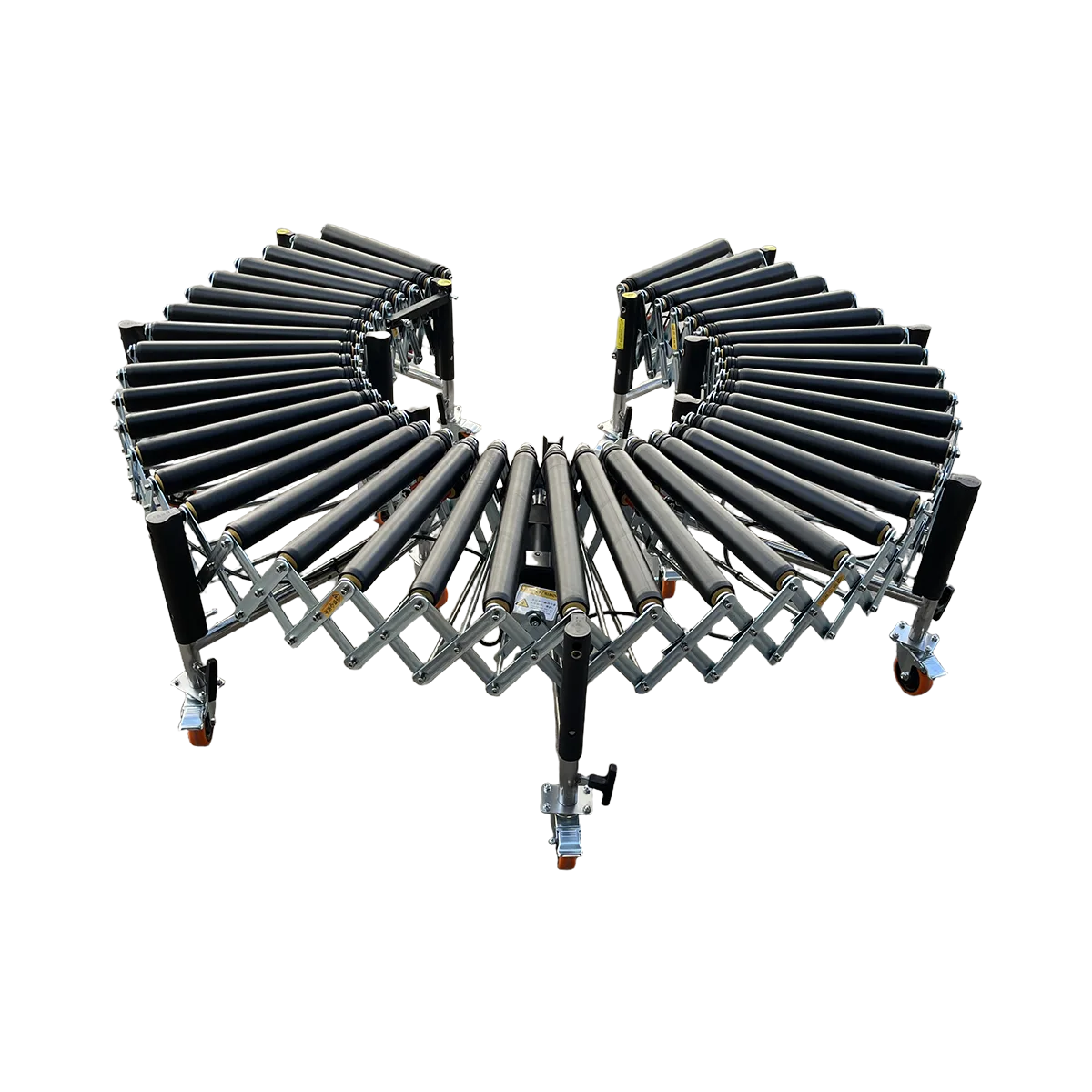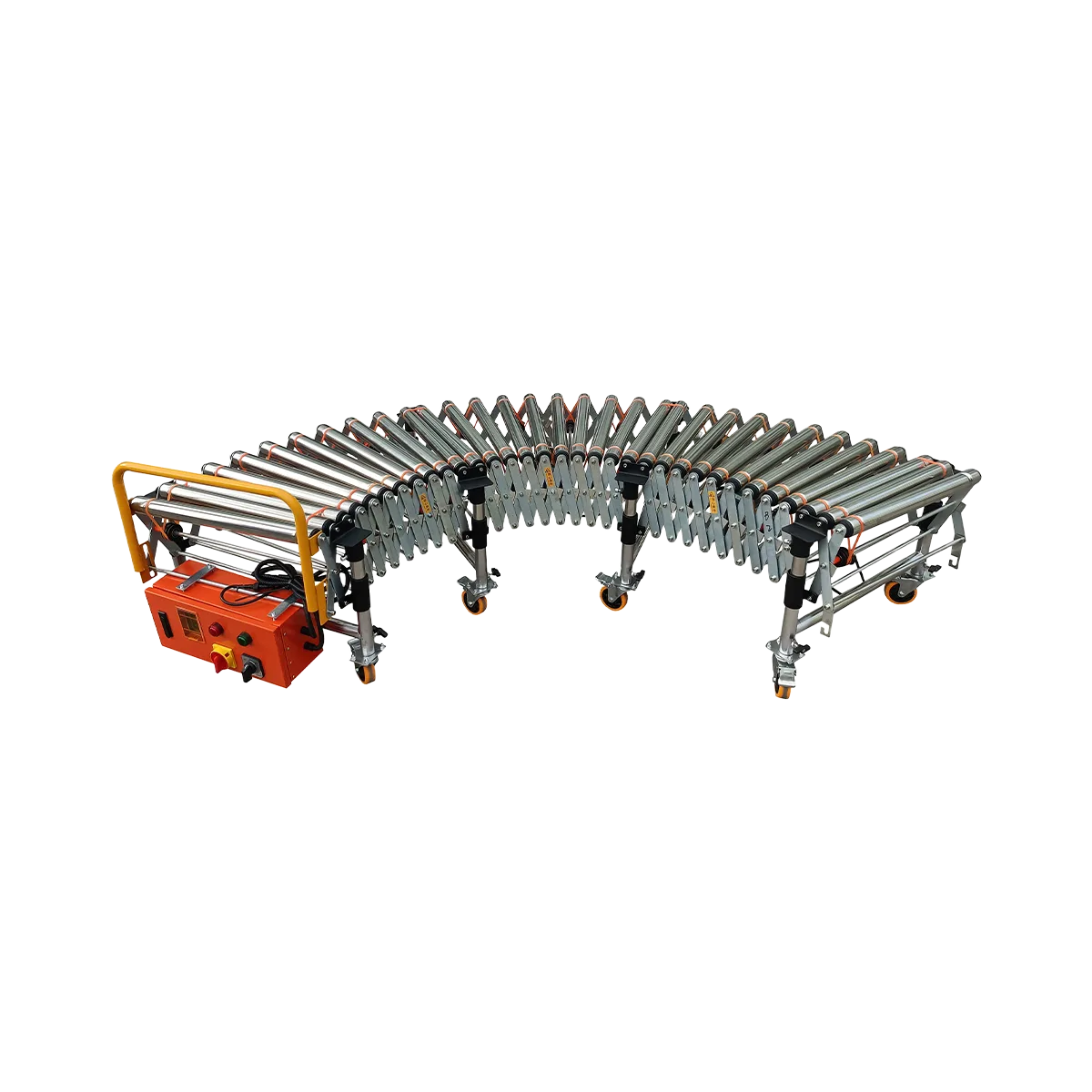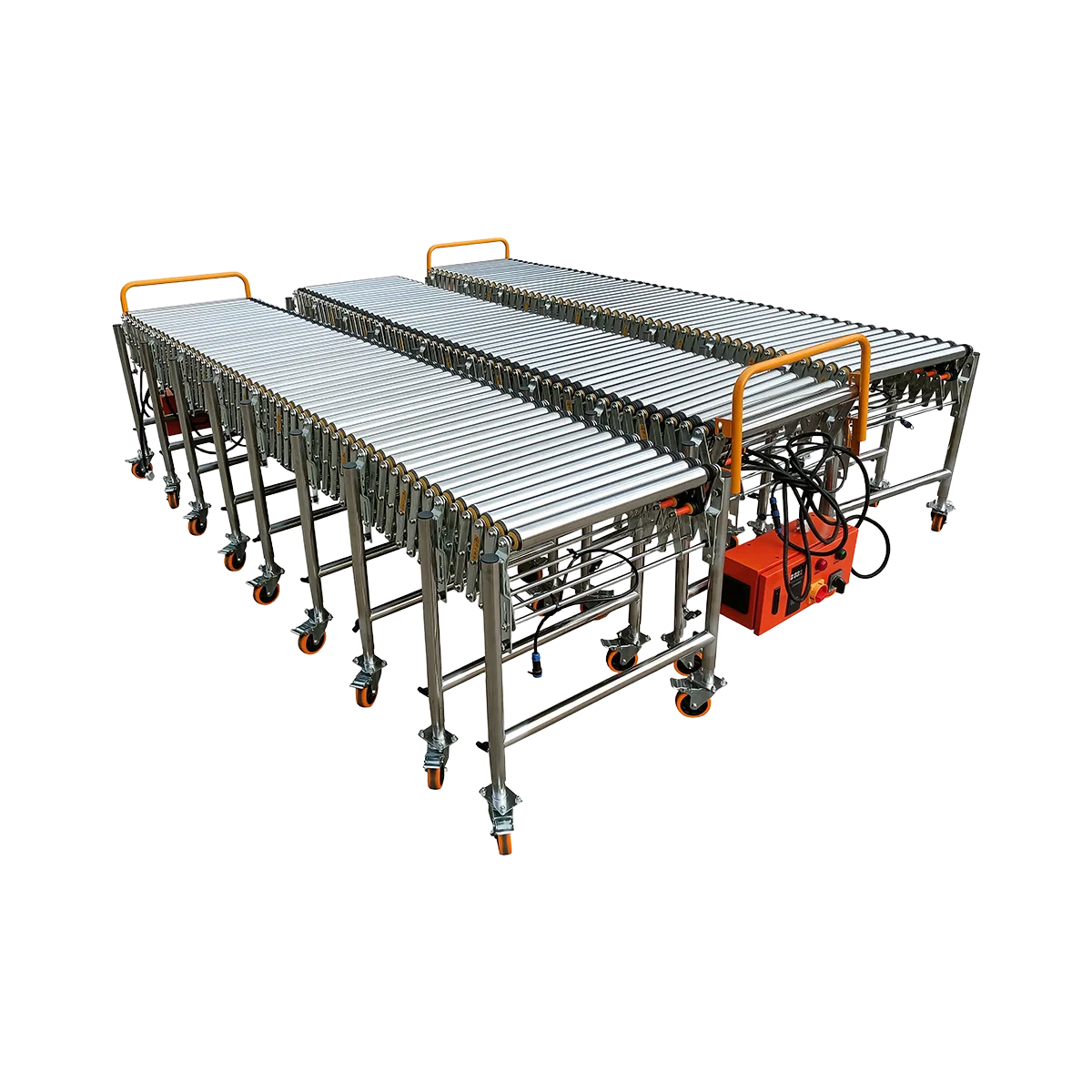Warehouse Conveyor Solutions for Apparel and Fashion Distribution
Discover efficient apparel logistics conveyor solutions that streamline fashion distribution centers, boost throughput, and handle clothing boxes with the precision this industry demands.
Related Products
-
Powered Rubber Roller Conveyor – Multi-wedge Belt Driven – 1100 mm/SectionCollapsed Length
560 mm
Extended Length1100 mm
Load Capacity120 kg/m
Applicable GoodsFlat-bottomed Goods
Bagged Goods
-
Powered Roller Conveyor – O-shaped Belt Driven – 1500 mm/SectionCollapsed Length
525 mm
Extended Length1500 mm
Load Capacity80 kg/m
Applicable GoodsFlat-bottomed Goods
-
Powered Roller Conveyor – Multi-wedge Belt Driven – 2000 mm/SectionCollapsed Length
700 mm
Extended Length2000 mm
Load Capacity100 kg/m
Applicable GoodsFlat-bottomed Goods
-
Powered Roller Conveyor – Multi-wedge Belt Driven – 3000 mm/SectionCollapsed Length
1050 mm
Extended Length3000 mm
Load Capacity80 kg/m
Applicable GoodsFlat-bottomed Goods
The fashion and apparel industry operates in a uniquely challenging logistics environment where speed, precision, and careful handling converge. Modern apparel logistics conveyor systems must efficiently process thousands of relatively lightweight cartons containing clothing items that require gentle handling while meeting the industry’s demanding seasonal peaks and rapid inventory turnover. As fashion distribution centers handle increasing volumes with tighter delivery windows, implementing the right material handling infrastructure becomes critical to maintaining competitive advantage.
Fashion distribution presents specific challenges that standard warehouse equipment often struggles to address effectively. The ideal conveyor system for clothing boxes must balance speed with careful handling, flexibility with reliability, and scalability with space efficiency—all while accommodating the industry’s distinctive workflow patterns.
The Challenge: Moving Thousands of Lightweight Boxes Through Complex Distribution Paths
The Unique Nature of Fashion Distribution
Fashion and apparel distribution centers face several distinctive challenges:
- High SKU Count: A typical fashion warehouse may manage tens of thousands of unique SKUs across multiple sizes, colors, and styles
- Seasonal Peaks: Fashion’s seasonal nature creates dramatic volume fluctuations that systems must accommodate
- Variable Package Sizes: From small accessory boxes to large garment cartons, with most being relatively lightweight
- Rapid Inventory Turnover: Fast fashion particularly requires systems that can handle quick product transitions
- Omnichannel Fulfillment: Simultaneously processing wholesale, retail replenishment, and direct-to-consumer orders
- Value Preservation: Avoiding damage to high-value, easily marred merchandise
Traditional warehouse handling methods often fall short in this environment. Manual carrying creates bottlenecks and increases labor costs, while heavy-duty industrial conveyors may be excessive for the relatively lightweight loads typical in apparel distribution.
The Flow Requirements
A fashion distribution center typically requires multiple interconnected processes:
- Receiving: Efficiently unloading incoming shipments from suppliers
- Sortation: Directing items to appropriate storage or processing areas
- Storage Access: Moving items to and from storage locations
- Order Fulfillment: Collecting and consolidating items for specific orders
- Packing: Transporting items to packing stations
- Outbound Shipping: Moving packed orders to shipping areas
Each of these processes involves moving numerous small to medium-sized cartons through the facility, often requiring changes in direction, merging of product flows, and distribution to multiple destinations.
The Naili Solution: Multi-Section Powered Roller Conveyor System
Why Powered Conveyors Excel in Fashion Distribution
Powered roller conveyor systems offer significant advantages over gravity-based alternatives for apparel distribution centers:
- Consistent Flow Control: Maintains precise spacing between packages regardless of weight variations common in apparel shipments
- Horizontal Transport: Operates effectively on flat surfaces, maximizing usable warehouse space without requiring sloped sections
- Bidirectional Capability: Can move products forward or reverse as needed for flexible routing
- Speed Regulation: Adjustable conveyor speed matches the pace of workers and downstream processes
- Reliable Performance: Ensures steady movement even for very light clothing boxes that might stall on gravity systems
- Extended Distances: Capable of moving products over longer horizontal distances without relying on gravity
- Workflow Integration: Easily integrates with manual sorting operations common in fashion distribution
For fashion warehouses processing thousands of lightweight cartons daily, these advantages translate directly into higher throughput, reduced labor requirements, and more consistent operations.
Optimal Configuration for Apparel Handling
The ideal powered roller conveyor configuration for fashion distribution centers includes:
1. Width Selection
The 600mm width option is particularly well-suited for standard apparel cartons:
- Wide enough to accommodate most clothing boxes and poly bags
- Narrow enough to maintain space efficiency in the warehouse
- Perfect balance between capacity and footprint
2. Section Type Selection
For fashion distribution with primarily lightweight packages (under 60kg):
- O-type Belt Drive 1500mm Sections: Ideal for most fashion applications
- Expandable from 525mm to 1500mm (1:3 ratio)
- 80kg/m load capacity (exceeding requirements for most apparel)
- Lower noise operation for better working environment
- More economical for lightweight applications
For operations handling heavier cartons or requiring higher throughput:
- Multi-wedge Belt Drive 3000mm Sections: Better for longer straight runs
- Expandable from 1050mm to 3000mm
- Same 80kg/m capacity but with longer individual sections
- Reduces the number of connections needed for extended runs
3. Speed Control Systems
Variable frequency drives allow precise speed adjustment from 0.3-40 m/min, critical for:
- Matching the pace of picking operations in fashion fulfillment
- Adjusting to different product types (delicate items vs. robust packaging)
- Synchronizing with downstream packing operations
- Accommodating seasonal volume fluctuations
4. Height Adjustability
The adjustable leg height (450-1500mm range) enables:
- Ergonomic working heights for different operations
- Creation of multi-level systems where needed
- Adaptation to existing infrastructure
- Optimization for different worker heights and tasks
Throughput Capabilities for Fashion Items
When properly configured, powered roller conveyor systems can achieve impressive throughput rates for typical fashion items:
| Product Type | Typical Weight | Pieces Per Hour |
|---|---|---|
| Small apparel boxes (accessories, folded items) | Under 5kg | 3,500-5,000 |
| Medium garment cartons | 5-15kg | 2,500-3,500 |
| Large or multi-item fashion boxes | 15-30kg | 2,000-2,500 |
These rates make powered roller systems ideal for fashion distribution centers handling thousands of items daily, with the ability to scale throughput by adding parallel lines during peak seasons.
A Sample Layout: Creating an Efficient Fashion Distribution Flow
Main Trunk Line with Manual Diverters
An effective layout for apparel distribution typically features a main powered trunk line with strategically positioned manual diverting points:
- Receiving Area Integration:
- Multiple receiving stations feed onto a central powered conveyor
- Initial section allows for barcode scanning and routing decisions
- Variable speed control matches the pace of receiving operations
- Central Trunk Line:
- Main powered conveyor serves as the primary transport artery
- Typically 600mm width to accommodate standard fashion cartons
- Connected sections create continuous flow path through the facility
- Speed set to optimize overall system throughput
- Manual Divert Points:
- Strategic positioning at key decision points in the workflow
- Workers manually direct cartons to appropriate secondary lines
- Simple, reliable operation without complex automated components
- Flexibility to adjust routing based on changing needs
- Secondary Lines to Destinations:
- Shorter powered sections leading to specific work areas
- Feed packing stations, quality control points, or outbound shipping
- Can be configured as perpendicular spurs from the main line
- Individual speed control for each destination line
- Workstation Integration:
- Height-adjusted sections at workstations for ergonomic access
- Potential stop/start controls at key workpoints
- Space for workers to access products from both sides where needed
Workflow Optimization
This layout supports the typical fashion distribution workflow:
- Receiving and Induction:
- Cartons from receiving are placed on the powered conveyor
- Initial scanning/labeling occurs at induction points
- System begins controlled movement through the facility
- Sorting and Routing:
- Workers at manual divert points read labels or scan barcodes
- Based on destination, items are directed to appropriate secondary lines
- Main trunk line maintains consistent flow while decisions are made
- Workstation Processing:
- Items arrive at workstations at a controlled pace
- Workers perform value-added tasks (inspection, special packaging, etc.)
- Completed work is returned to the conveyor system
- Consolidation and Shipping:
- Processed items converge at packing or shipping areas
- Final preparation for outbound transport
- Loading onto outbound vehicles
This workflow minimizes manual carrying, reduces worker fatigue, and maintains consistent throughput even during peak periods—all critical factors in fashion distribution where seasonal spikes can create significant operational challenges.
Implementation Considerations for Fashion Distribution
Space Utilization
Fashion distribution centers often operate in environments where space is at a premium, particularly in urban locations close to retail centers. Powered roller conveyors offer several space optimization advantages:
- Expandable/Collapsible Design: Sections can be extended when in use and collapsed for storage
- Vertical Space Utilization: Adjustable heights allow for multi-level operations where appropriate
- Flexible Routing: Ability to create space-efficient paths through the facility
- Modular Expansion: System can grow with the business without requiring complete reconfiguration
Seasonal Adaptability
Fashion’s seasonal nature demands systems that can scale up and down efficiently:
- Modular Components: Additional sections can be deployed during peak seasons
- Variable Speed: Throughput can be increased by adjusting conveyor speeds
- Reconfigurable Layout: Sections can be repositioned to accommodate seasonal workflow changes
- Storage When Not Needed: Collapsible design allows for efficient storage during off-peak periods
Integration with Manual Operations
While the powered conveyor provides the transportation backbone, fashion distribution typically requires significant manual operations for tasks requiring human judgment:
- Quality Inspection Points: Conveyors deliver items to quality control stations
- Special Handling Areas: Delicate or high-value items can be routed to specialized processing
- Value-Added Services: Gift wrapping, special packaging, or customization stations
- Exception Processing: Items requiring special attention can be diverted from the main flow
The ideal system balances automation of routine transport with the flexibility of manual operations where human skills add the most value.
Conclusion: Keeping Apparel Moving at Fashion’s Pace
In the fast-paced world of fashion distribution, the ability to move thousands of items quickly, efficiently, and carefully through the warehouse directly impacts bottom-line performance. A well-designed powered roller conveyor system from Naili provides the ideal balance of speed, flexibility, and reliability that apparel logistics operations demand.
By implementing a multi-section powered roller conveyor system with:
- Appropriate width selection for standard apparel cartons
- Variable speed control to match workflow demands
- Strategic manual divert points for efficient routing
- Modular design for seasonal adaptability
Fashion distributors can achieve significant operational improvements:
- Increased throughput during critical seasonal peaks
- Reduced labor costs and improved ergonomics
- More consistent and predictable operations
- Enhanced ability to meet tight shipping deadlines
- Better preservation of merchandise condition
In an industry where timing is everything, the right conveyor system ensures that your apparel distribution center can keep pace with fashion’s demanding rhythms—getting the right products to the right destinations at the right time, season after season.
Frequently Asked Questions
What makes apparel distribution different from other types of warehouse operations?
Apparel distribution typically involves handling thousands of relatively lightweight cartons containing high-value, easily damaged merchandise across a vast number of SKUs with significant seasonal volume fluctuations and rapid inventory turnover.
Can powered roller conveyors handle poly bags commonly used in e-commerce apparel shipping?
Yes, the 600mm width powered roller conveyor with closely spaced rollers (especially the O-type belt drive system) handles poly bags effectively, though for very small or unusually shaped packages, side guards may be recommended at curves or transitions.
What is the typical ROI period for implementing a powered conveyor system in a fashion distribution center?
For operations handling over 1,000 packages daily, ROI is typically achieved within 12-18 months through labor savings, increased throughput, reduced product damage, and improved order fulfillment accuracy.
How can a fashion distribution center adapt the conveyor system for peak seasons?
The modular nature of Naili’s powered roller conveyors allows for adding additional sections during peak periods, adjusting speeds to increase throughput, creating temporary parallel processing lines, and reconfiguring the layout to accommodate seasonal workflows.
What maintenance is required for powered roller conveyors in a fashion distribution environment?
Maintenance is minimal, requiring weekly visual inspections, monthly drive belt tension checks, quarterly bearing lubrication, and immediate replacement of any damaged rollers. The typical service life is 5-10 years with proper care.
Table of Contents
Recent Posts
Discover how gravity roller conveyors can transform beverage unloading operations, reducing time and labor while handling heavy drink cartons with remarkable efficiency.
Discover how to select the perfect conveyor width for your warehouse operations. Our expert guide helps you match box sizes to conveyor dimensions for optimal efficiency and fewer jams.
Discover effective outdoor conveyor solutions for connecting warehouse to truck across open yards. Our guide to all-weather yard logistics will transform your loading efficiency.




